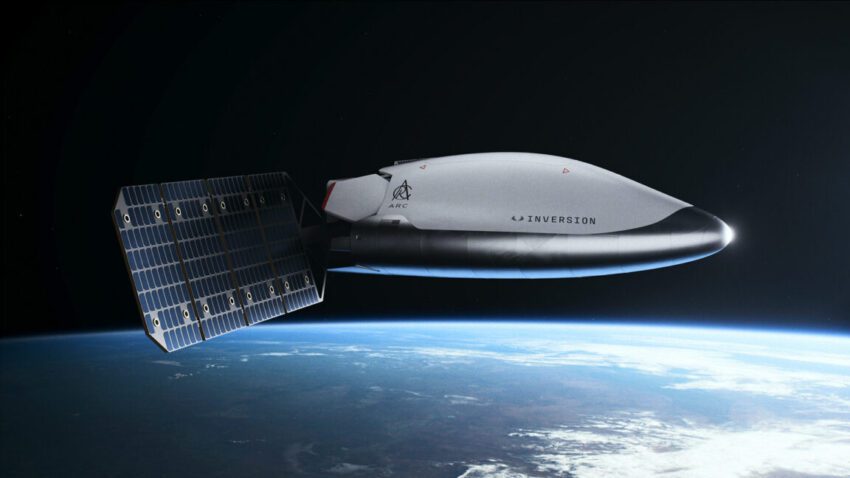
meet the arc spacecraft it aims to A new spacecraft company, Inversion, has unveiled its innovative “on demand” delivery vehicle, the Arc spacecraft, which aims to revolutionize cargo delivery for the US military.
meet the arc spacecraft it aims to
Introduction to Inversion and the Arc Spacecraft
Inversion, a relatively new player in the aerospace industry, has made headlines with the introduction of its Arc spacecraft. The announcement was made during a high-profile ceremony at the company’s factory in Los Angeles. This ambitious project is designed to enhance logistical capabilities for the US military, allowing for rapid delivery of supplies to virtually any location on Earth.
Capabilities of the Arc Spacecraft
The Arc spacecraft is engineered to transport up to 500 pounds (225 kg) of cargo, which could include essential supplies, equipment, or humanitarian aid. The design focuses on speed and efficiency, with the goal of delivering cargo to its destination in under an hour. This capability is particularly significant for military operations, where timely access to resources can be critical.
Mission Profile
According to Justin Fiaschetti, co-founder and chief executive of Inversion, the nominal mission profile for the Arc involves pre-positioning multiple spacecraft in orbit. These vehicles would remain in space for up to five years, ready to be deployed autonomously whenever needed. This strategic positioning allows for immediate response to various situations, whether they be military engagements, disaster relief efforts, or other urgent logistical needs.
Autonomous Operations
The autonomous nature of the Arc spacecraft is a key feature. Once activated, the spacecraft would be capable of navigating to its designated landing site without human intervention. This reduces the time required for decision-making and execution, allowing for rapid deployment of resources. The technology behind this autonomy is expected to rely on advanced navigation systems and artificial intelligence, enabling the spacecraft to assess its environment and make real-time adjustments as necessary.
Technological Innovations
The development of the Arc spacecraft incorporates several cutting-edge technologies. These innovations are crucial for achieving the ambitious goals set by Inversion.
Propulsion Systems
One of the most significant aspects of the Arc’s design is its propulsion system. The spacecraft is expected to utilize a combination of traditional rocket propulsion and advanced technologies that may include electric or hybrid systems. This combination aims to optimize fuel efficiency while maximizing speed and payload capacity.
Materials and Design
The materials used in the construction of the Arc spacecraft are also noteworthy. Inversion is likely employing lightweight, durable materials that can withstand the rigors of space travel while ensuring structural integrity during re-entry and landing. The design is expected to be streamlined to minimize drag and enhance aerodynamic performance, which is essential for achieving the rapid delivery times promised by the company.
Strategic Implications for the Military
The introduction of the Arc spacecraft could have profound implications for military logistics. Traditional supply chains often face delays due to transportation limitations, geopolitical factors, and other logistical challenges. The ability to deliver cargo almost instantaneously can enhance operational readiness and flexibility.
Enhancing Operational Readiness
With the Arc spacecraft, military units could receive critical supplies in real-time, allowing them to maintain momentum in various operations. This capability could be particularly valuable in conflict zones where access to resources is limited. The rapid delivery of medical supplies, ammunition, or food could significantly impact the effectiveness of military missions.
Humanitarian Applications
Beyond military applications, the Arc spacecraft holds promise for humanitarian efforts. In disaster-stricken areas, where traditional supply routes may be compromised, the ability to deliver aid quickly can save lives. The spacecraft could transport medical supplies, food, and other essential items to remote locations, providing immediate relief to those in need.
Stakeholder Reactions
The announcement of the Arc spacecraft has garnered attention from various stakeholders, including military officials, aerospace experts, and potential investors. Reactions have been largely positive, with many recognizing the potential of such technology to transform logistics.
Military Officials
Military officials have expressed interest in the capabilities offered by the Arc spacecraft. The prospect of enhanced logistical support aligns with ongoing efforts to modernize military operations. The ability to deploy resources quickly and efficiently is viewed as a critical advantage in contemporary warfare.
Aerospace Community
Members of the aerospace community have also reacted favorably to the announcement. Experts recognize the challenges associated with developing a spacecraft capable of rapid delivery and autonomous operations. However, many are optimistic about Inversion’s approach and the potential for collaboration within the industry to bring such innovations to fruition.
Challenges Ahead
Despite the excitement surrounding the Arc spacecraft, several challenges remain. The development of new technologies often encounters hurdles, from engineering difficulties to regulatory approvals.
Technical Challenges
One of the primary challenges will be ensuring the reliability and safety of the spacecraft. Autonomous systems must be rigorously tested to prevent failures during critical missions. Additionally, the integration of advanced propulsion systems and navigation technologies will require significant research and development efforts.
Regulatory Hurdles
Regulatory approval is another significant challenge. The aerospace industry is heavily regulated, and any new spacecraft must comply with a myriad of safety and operational standards. Inversion will need to work closely with regulatory bodies to ensure that the Arc spacecraft meets all necessary requirements before it can be deployed for operational use.
Future Prospects
The future of the Arc spacecraft appears promising, but its success will depend on the ability of Inversion to navigate the challenges ahead. If successful, the Arc could set a new standard for cargo delivery in both military and civilian contexts.
Potential for Commercial Applications
While the initial focus is on military applications, the technology developed for the Arc spacecraft could have commercial implications as well. The ability to deliver goods quickly and efficiently could appeal to various industries, including e-commerce, pharmaceuticals, and disaster response organizations. This opens up avenues for partnerships and collaborations that could further enhance the capabilities of the Arc.
Long-Term Vision
Inversion’s long-term vision for the Arc spacecraft includes not only military and humanitarian applications but also the potential for broader use in global logistics. As the demand for rapid delivery services continues to grow, the Arc could play a pivotal role in shaping the future of supply chain management.
Conclusion
The unveiling of the Arc spacecraft by Inversion marks a significant development in the field of aerospace technology. With its focus on rapid, autonomous cargo delivery, the Arc has the potential to transform military logistics and humanitarian efforts alike. While challenges remain, the innovative approach taken by Inversion could pave the way for a new era of efficient and effective supply chain solutions.
Source: Original report
Was this helpful?
Last Modified: October 2, 2025 at 7:37 pm
0 views















